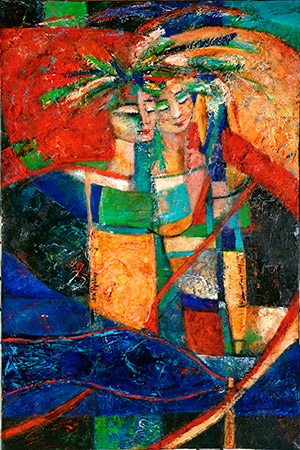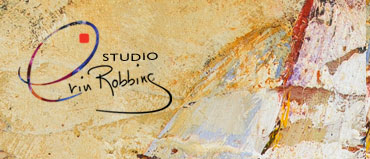
Attention grabbing. With Erin Robbins’ paintings you just have to look. They cannot be ignored. Vibrant color used with sophisticated flair brings worldly stories to life. A woman in peaceful repose sports a Mardi Gras feather boa and hat sprouting multi-colored ribbons in “Two as One”. Turquoise skin on a woman in “Allies” heightens the passion between her and her lover. The focus is color. Rich applications of deep blacks and mid-night blues paired with cherry reds have a jewel-like quality, causing the paintings to appear as stained glass lit from within. Her wise use of complementary colors enhance the painting’s overall swirling movement. Playful relief texture underlying the bold color creates a sensuous surface.
By adapting universal forms for her narrative elements, Robbins allows the viewer to take on their own experience, and create their own stories. The “every-woman”, the ideal bird, readily recognizable horse, and “handsome prince” staged on a seductive textural glowing surface, allow multiple interpretations. Robbins’ trademark play of space adds to the seduction. Paintings in general contain a certain level of visual tension as the viewer attempts to relate their three dimensional experience in the physical world with the two dimensions of a painting. Robbins creates a high level of visual tension in her work by using contradictory modes of spatial arrangements. Abundant areas of solid color, like the cherry red in “Marriage I”, and startling geometry, as seen in “Gentle Love” create a flat confrontational space. By incorporating narrative elements such as people and animals into this flat space, the viewer’s eyes flicker between the illusion of deep soothing background space and close-up intimate space.
Robbins’ earlier series flirt with the Modern Masters, offering hints of Gauguin in “Manawa a Me Aloha”, Picasso in “Wise Spirit”, and Gustav Klimt in “Love’s Melody”. The “push-pull” of Hans Hoffmann is well utilized in “It is Between Us”. Robbins multi-cultural resources also include traditional eastern styles, as seen in “Secret Ecstasy” and “When Love Comes”. Robbins even embraces Abstract Expressionist modes as she freely adds lines, marks and geometric shapes in her atmospheric arenas. Circles are placed boldly behind a bird, encircling the tranquil faces of lovers, used for focus around an embrace, doorway, or as a symbolic footnote. All told, Robbins’ story-line is playful, bold, alluring and dramatic.
By Nancy Reyner; painter, writer, educator



